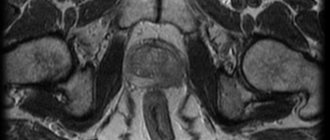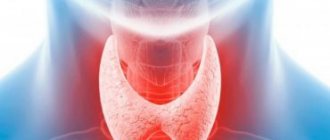Alternative name for the condition: benign prostatic hyperplasia (BPH).
An adenoma is a growth of the glandular tissue of the prostate, as a result of which the organ increases in size. Prostate hyperplasia is a pathology that affects the reproductive and urinary system in men. In women, pathology does not occur due to the absence of the prostate gland.
The incidence of prostatic hyperplasia increases with age. The older a man gets, the greater the risk of prostate tissue enlargement. In the first stages, BPH may have an asymptomatic or low-symptomatic course, which makes early diagnosis difficult.
According to statistics, prostate adenoma occurs in more than 50% of men over the age of 60 years. This disease significantly reduces the quality of life of the male half of humanity, leads to acute urinary retention, psychological discomfort, etc.
Structure and functions of the prostate gland
The prostate is an organ that synthesizes and secretes a complex secretion that is part of the seminal fluid of men. It contains:
- acid phosphatase;
- lemon acid;
- fibrinolysin;
- prostate-specific antigen;
- protein complexes.
It is thanks to the secretion of the prostate that sperm become more mobile, which increases the possibility of fertilization. This fluid is released into the urethra during ejaculation.
Another important feature of prostate secretion is the ability to change the pH of the partner’s vagina. This results in sperm being able to survive for a longer period of time, which also increases the likelihood of conception.
The prostate gland is capable of growth throughout a person's life. This feature is associated with a thin capsule of the organ, which is well nourished by blood vessels. Significant enlargement of the prostate gland leads to pain and discomfort due to pressure on neighboring organs and systems. Therefore, men require complex treatment.
Why can the prostate become enlarged? What is the probability of getting sick?
Throughout life, the activity of organs is regulated by 2 systems: nervous and humoral. The latter includes hormonal regulation. It's no secret that the balance of hormones changes with age. In men, the amount of estrogen gradually increases, which leads to an increase in the activity of 5-alpha reductase. Under the influence of the enzyme, reactions occur:
- testosterone in prostate tissue is converted to dihydrotestosterone (DHT);
- DHT promotes increased division of prostate cells;
- hyperplasia leads to the formation of nodes from the paraurethral glands;
- as a result, the prostate tissue is pushed to the periphery.
Prostate adenoma develops under the influence of 2 main mechanisms:
- Enlargement of the prostate gland. This process leads to a gradual narrowing of the lumen of the urethra and, accordingly, urinary retention.
- Increased tone of smooth muscle fibers. The tense stroma of the prostate and posterior urethra leads to an even greater narrowing of the canal, aggravating the existing problem.
All cells of the organ participate in the enlargement of the prostate gland and the formation of nodes. “Adenoma” is more of a historical term, since it does not fully reflect the essence of the pathophysiological process in the organ. The term “benign prostatic hyperplasia” is able to more accurately reflect the essence of the pathology, since the formation of nodes occurs not only due to glandular tissue, but also the stroma.
In most modern documents, the abbreviation “BPH” is fixed, but “benign prostate adenoma” also remains common in colloquial speech.
Medicines to treat prostate problems
In drug therapy for BPH (conservative treatment), there are two main groups of active ingredients: alpha blockers and reductase inhibitors.
Alpha blockers have a therapeutic muscle relaxant effect on smooth muscles. By relaxing the smooth muscle cells present in the prostate and bladder, the pressure decreases and symptoms improve significantly. Improvement in urinary symptoms begins within a few days.
Reductase inhibitors suppress the formation of the active form of testosterone. This process occurs in the cells of the prostate gland. When the 5-alpha reductase enzyme is blocked, testosterone is unable to convert into its active form and therefore has no effect on prostate cells.
The use of a reductase inhibitor in patients with higher grades of BPH is advisable because treatment may result in a reduction in prostate size. The results of therapy begin to appear after about three months.
Prevalence of prostate adenoma
Benign prostatic hyperplasia is not just a common disease, but also a whole social problem. To understand this, just look at the numbers:
- 10% of men aged 40 years have the first signs of hyperplasia (changes at the cellular level).
- By the age of 50, the number of men with prostate hyperplasia increases to approximately 33%.
- By age 60, the incidence of adenoma reaches 50%.
- And at the age of 80, up to 80% of men have benign growths of the prostate gland.
And if the relevance of reproductive issues decreases with age, then pathological conditions of the urinary tract become the cause of severe physical and psychological discomfort.
There is some geographic pattern in the prevalence of prostate adenoma. This pathology is less common in residents of Southeast Asia.
Treatment of mild forms of BPH
In many cases, benign prostatic hypertrophy does not require treatment at all, or treatment is not very difficult.
Your doctor plans treatment for BPH depending on the severity of your complaints, test results, and the patient’s general condition. Treatment may be surgery or medication, including other complementary methods.
In some cases, the wait-and-see approach can be used because immediate intervention is not always required. If symptoms are mild and tests rule out complications or other abnormalities, there is a high probability that the condition will not worsen. In such cases, follow-up examinations are carried out at regular intervals. It is very important that the patient understands the importance of follow-up tests. Therefore, this path is only possible for conscious patients.
Causes of development: who is at risk of developing prostate adenoma?
In order to avoid the development of pathology or reduce its risks, it is necessary to know the factors that contribute to hyperplasia. There are only 2 factors that significantly increase the risk of developing prostate adenoma:
- age;
- hormonal status.
With age, the risk of prostate adenoma increases significantly. At the same time, an increase in the risk of developing BPH is facilitated by changes in hormonal levels: an increase in estrogen levels in men.
Research shows that prostatic hyperplasia does not develop in boys who were castrated before puberty. At the same time, if there is a hereditary predisposition to the pathology, the risk of adenoma increases. Therefore, special attention to early prevention of the disease should be paid to men whose fathers suffered from this disease and symptoms of prostate hyperplasia.
There is no reliable information that infections of the genitourinary system can lead to hyperplasia of prostate tissue.
Reasons for the development of hyperplasia
The main reason for development is the action of hormones. With age, the male body ceases to produce testosterone (male sex hormone) in sufficient quantities. Because of this, tissue proliferation occurs.
Several factors also influence the occurrence of pathology. These include:
- heredity (the risk of developing a tumor increases if cases have been registered in close relatives);
- overweight;
- chronic diseases (diabetes mellitus);
- unbalanced diet;
- chronic infections of the reproductive system.
Can an adenoma transform into prostate cancer? Malignant neoplasm?
Prostate adenoma is a benign tumor. Its cells are well differentiated and perform their functions fully. Health problems develop precisely due to the increase in size of the organ. Adenoma cells cannot metastasize and grow into neighboring structures.
Previously, there was an opinion that the lack of treatment for prostate adenoma leads to the development of an oncological process. However, most modern studies deny this pattern. Most benign tumors in the human body are incapable of malignant transformation.
Are adenoma and prostatitis the same thing?
No, these are two completely different diseases that affect the same organ. Prostate adenoma develops under the influence of hormonal factors. At the same time, prostatitis is an inflammatory disease. It is provoked by bacteria and viruses.
However, there is evidence that the lack of adequate treatment for BPH can lead to the development of prostatitis. Making a preliminary diagnosis is also simplified by the age of the patients:
- Prostate adenoma often develops in older men;
- Prostatitis affects men of reproductive age, mainly due to sexually transmitted infections.
Only a doctor can make a final diagnosis based on examination data, instrumental and laboratory research methods. Self-medication of both diseases can lead to their progression and the development of complications.
Symptoms of benign prostatic hyperplasia
One of the most common manifestations of prostate adenoma is urinary disorders. Most often, the lower urinary tract reacts to changes in prostate size. The medical literature uses the term “lower urinary tract symptoms.” These include manifestations such as problems with emptying and filling the bladder, as well as conditions that occur after the end of urine output.
Most symptoms of prostatic hyperplasia are not life-threatening. However, they can significantly reduce the quality of life and force the patient to experience psychological discomfort.
Among the clinical manifestations of benign prostatic hyperplasia are:
- Urgency. A condition characterized by an unbearable urge to urinate that cannot be controlled.
- Pollakiuria. During the daytime, the number of normal urinations can reach 8. If the patient needs to visit the toilet more often, this indicates the development of pathological symptoms. Of course, this situation does not take into account situations where increased urine output is associated with drinking large amounts of liquid and/or taking diuretics.
- Small-volume urination that is not associated with kidney pathologies and dehydration.
- Drip of urine after urination.
- Nocturia. The number of nighttime urinations should not be more than 2. If this happens more often, then this symptom indicates the development of a pathological process in the genitourinary system.
- Enuresis. This condition is characterized by involuntary urination during sleep.
- Weak stream of urine.
- Intermittent stream of urine. In this case, the interruption must be involuntary.
- The need for straining. If a man has to strain to completely empty the bladder, then this also indicates the development of pathology.
Prostate adenoma is extremely rarely characterized by fulminant development of symptoms. Much more often, this condition is characterized by a gradual increase and decrease in symptoms.
At the initial stage, the bladder and urinary tract are affected. Therefore, only urination disorders develop.
Congestion in the bladder leads to the development of renal pathology. Residual urine contributes to kidney infection, as well as the formation of stones in the lumen of the bladder.
Due to the fact that the enlarged prostate gland interferes with the outflow of urine, the ureters and renal pelvis are stretched. Inflammation gradually develops, which leads to the formation of pyelonephritis. If treatment is not started at this stage, then soon prostate adenoma will become a source of such acute conditions as:
- bladder obstruction;
- acute urinary retention;
- chronic renal failure.
Each of these conditions is life-threatening for the patient and requires immediate medical attention. If the adenoma leads to the development of such complications, then a long period of treatment and rehabilitation will be required. Therefore, it is extremely important to monitor your health and begin timely treatment of pathologies.
Our doctors
Kochetov Sergey Anatolievich
Urologist, Candidate of Medical Sciences, doctor of the highest category
34 years of experience
Make an appointment
Khromov Danil Vladimirovich
Urologist, Candidate of Medical Sciences, doctor of the highest category
35 years of experience
Make an appointment
Mukhin Vitaly Borisovich
Urologist, Head of the Department of Urology, Candidate of Medical Sciences
34 years of experience
Make an appointment
Perepechay Dmitry Leonidovich
Urologist, Candidate of Medical Sciences, doctor of the highest category
40 years of experience
Make an appointment
How does prostate adenoma form?
The development of benign prostatic hyperplasia is a multifactorial process. Some of them are more important, some less. However, the more factors that affect the body simultaneously, the greater the risk of adenoma formation. The main influence on the formation of BPH is exerted by:
- hormonal background;
- hereditary predisposition;
- individual characteristics of stromal-epithelial interaction;
- inadequate exposure to growth factors (their excessive accumulation in the blood and prostate gland);
- tissue hypoxia (oxygen deficiency in the cells of the body or prostate gland);
- chronic inflammation of the prostate gland.
The basis of prostatic hyperplasia is an imbalance in the reproduction and destruction of cells. The processes of proliferation (division) prevail over apoptosis (death) of cells. At the initial stages, changes in the prostate are practically invisible: they can only be detected by histological examination.
First, small microscopic clusters of cells appear. They gradually grow and multiply, due to which the organ increases in size. At the same time, the amount of not only glandular tissue, but also stromal tissue in the prostate increases. An absolutely normal phenomenon is the dominant growth of one of the cell types while the second type is slower.
Due to active growth, the organ capsule stretches, the smooth muscles become hypertonic. Many manifestations of prostate pathology are associated with its anatomical position. Excessive growth of the organ leads to the development of compression and even complete obstruction of the urethra.
The main stimulus for the development of prostate adenoma is hormonal levels. Men and women aged 40-50 undergo hormonal changes. In representatives of the stronger sex, the amount of the male sex hormone, testosterone, decreases during this period. At the same time, the female hormone (estradiol) begins to increase its concentration in the blood.
An increase in the level of female sex hormones in a man’s body leads to the activation of connective tissue cells (fibroblasts). At the same time, the production of fibroplastic factor is stimulated and proliferation of connective tissue cells appears in the prostate gland.
Stages of the pathogenesis of benign prostatic hyperplasia:
- Testosterone is converted to dihydrotestosterone by 5-alpha reductase. This reaction leads to increased epithelial growth in the prostate gland.
- Increasing the level of estradiol in the body. An increased level of female sex hormones provokes the proliferation of tissue (stroma) in the prostate gland.
- Decreased concentration of 5-alpha-androstenediol. Leads to an increase in the sensitivity of receptors in the genitourinary system. As a result, a man often experiences a painful and uncontrollable urge to urinate. This leads to decreased sleep levels at night, as well as psychological discomfort during the day.
But this is not the end of the pathological changes in the prostate gland. The blood supply to the organ is disrupted. A favorable environment for the development of chronic inflammation is formed, swelling increases discomfort and pain during urination.
If the growth of prostate nodes goes in the direction of the lumen of the bladder, then discomfort may appear even in the early stages of the disease.
Transurethral needle ablation (TUNA: Trans Urethral Needle Ablation)
Radiofrequency radiation (465 kHz) is used for thermotherapy of the prostate. The result is thermocoagulative necrosis (temperature 110°C).
Targeted effect on BPH tissue (prostatic urothelium is not damaged). The irrigation system washes the urethra, preventing unwanted tissue damage.
Radiofrequency energy is supplied only to the area of direct contact with the needles, preventing damage to surrounding tissues and organs. The temperature in the prostate and urethra is measured 50 times per second for proper thermocoagulation of prostate tissue. The signal for urethral irrigation is activated at 43°C, and at 47°C it automatically switches off to prevent overheating of the urethra.
Classification of benign prostatic hyperplasia
There are several main classifications of prostate adenoma that are currently used.
For example, there is a classification according to the stages of clinical manifestations. The main criterion in this classification: the amount of residual urine after urination:
- Stage: up to 40 ml of fluid remains in the bladder.
- Stage: the amount of residual urine varies from 40 to 100 ml.
- Stage: up to 1.5 liters of fluid remains in the bladder.
As a result, this leads to the formation of paradoxical ischuria. In this condition, there is constant leakage of urine. The bladder is distended, its muscle tone is reduced. As a result, the sphincters are open and cannot retain fluid in the bladder.
Another common classification of prostate adenoma (according to Guyon):
- Compensated stage. There is no residual urine in the bladder. In this case, minor urinary disorders are observed.
- Subcompensated. There is residual urine in the bladder. Complications begin to develop.
- Decompensated. An extreme form of the disease. With it, paradoxical ischuria is observed, and chronic renal failure also develops. Also, in the decompensated stage, ureterohydronephrosis may develop. In this condition, the ureters and pelvic system of the kidneys dilate.
The Guyon classification is outdated, but its use is considered acceptable in many countries around the world.
Urine tests
Because BPH causes problems with emptying the bladder, a laboratory urine test is required to diagnose the condition.
Measuring urine flow is a simple method of determining the maximum flow rate and average urine flow rate. There is a curve regarding the dynamics of urine output, the shape of which conveys important information to the urologist, although decreased urine flow can be caused by other diseases of the prostate and bladder or urethra. The examination is painless.
It is also important to measure the amount of urine remaining in the bladder after urination. This is done using an ultrasound machine. The amount of residual urine can also be determined using catheterization.
What complications does prostate adenoma lead to?
Prostate adenoma is a disease that can cause only minor discomfort for a long time. Therefore, many patients postpone their visit to the doctor. However, like any other pathological process, prostate adenoma requires timely diagnosis and treatment by a specialized specialist.
If the problem is ignored for a long time, it can lead to the development of complications. The main ones are:
- chronic urinary retention;
- chronic pyelonephritis (can gradually progress and lead to the development of chronic renal failure);
- chronic urethritis (often);
- chronic cystitis (rare);
- epidymitis (acute and chronic).
The most serious complication of benign prostatic hyperplasia is acute urinary retention. This is an acute condition that requires immediate medical attention.
Why is acute urinary retention dangerous?
Acute urinary retention is an insidious disease in which an enlarged prostate gland leads to obstruction of the urethra. If measures are not taken to force the outflow of urine (installation of a tube into the bladder through the anterior abdominal wall), then the following may develop:
- uremic coma;
- ascending pyelonephritis;
- urethritis;
- prostatitis;
- urolithiasis disease;
- hematuria;
- erectile disfunction;
- mental disorders (due to intoxication of the body);
- uncontrolled urination.
Lack of treatment leads to rapid deterioration of the patient's condition.
What is the prostate: a little anatomy
The prostate is a gland, no larger than a walnut, located below the bladder in the pelvic cavity.
The prostate surrounds the urethra as it exits the bladder and merges with the vas deferens in the ejaculatory duct.
The prostate contains two main types of tissue: exocrine glandular and fibromuscular.
The first type of tissue is epithelial, specialized in the secretion of sperm components.
Most of the prostate consists of this tissue, since the main function of the prostate is the production of sperm.
Fibromuscular tissue is a mixture of smooth muscle tissue and connective tissue containing many collagen fibers.
These fibers provide strength to the tissue, while smooth muscle allows it to contract to expel fluid.
Fibromuscular tissue forms the outer layer of the prostate gland.
The prostate performs extremely important functions in the male genitourinary system.
Therefore, it is extremely important that every man over 45 years old undergoes preventive examinations of the prostate gland once a year by a urologist.
How to diagnose prostate adenoma?
In order to conduct a high-quality diagnosis and choose the right treatment tactics, a number of procedures will be required:
- Anamnesis collection.
- Patient completing voiding diaries independently.
- Filling out international IPSS questionnaires by the patient, as well as QOL. With their help, you can assess how symptoms from the genitourinary system affect the patient’s quality of life.
- Digital rectal examination of the prostate.
- Urine tests (general and bacteriological culture).
- Assessment of the functional state of the kidneys.
- Determination of the level of prostate-specific antigen.
- Diagnostic search for concomitant chronic diseases that can affect urination.
The last group includes:
- chronic forms of prostatitis;
- chronic pyelonephritis;
- chronic renal failure;
- prostate cancer;
- erectile disfunction;
- diabetes;
- urethral strictures;
- bladder tumors;
- pelvic tumors.
History taking
Talking with a patient is one of the most important parts of a doctor’s job. The right questions and detailed answers will help the specialist most accurately predict the disease. International questionnaires and questionnaires can improve this process. For many patients, it is much easier to honestly answer questions about their condition in a test format; this allows them to experience less psychological discomfort when it comes to such an intimate side of health.
Self-completion of voiding diaries allows you to assess:
- frequency of urination;
- their distribution during the day;
- volume of each urination;
- daily urine volume.
Physical examination
Digital rectal examination is an essential part of diagnosing prostate diseases. With its help, the doctor assesses the size of the gland, and also palpates its suspicious areas, which may be foci of an incipient oncological process.
PSA level determination
Determining the level of prostate-specific antigen is another important test that is performed for every man with suspected prostate adenoma. Its main goal is differential diagnosis. The PSA level can be used to judge the benign or malignant nature of the process.
At the same time, determining the PSA level makes it possible to predict the disease and understand how prostate adenoma will develop in the near future. The level of prostate-specific antigen may be elevated during exacerbation of prostatitis, so it is also important to inform your doctor about existing chronic diseases.
Voiding assessment
The average urine flow rate is one of the most important indicators in diagnosing prostate adenoma. In order to conduct the study, you will need only 2 simple items: a stopwatch and a container for collecting urine. When the patient begins to urinate into the measuring cup, start the stopwatch. To obtain the average urine flow rate, you need to divide the volume by the time. An indicator of more than 8-9 ml/s indicates that the rate of urination is within normal limits.
Uroflowmetry
This study is carried out to assess the maximum flow rate of urine. However, to obtain results, it is necessary that the patient experiences an adequate urge to urinate. A result of more than 15 ml/s is considered a normal value.
Transrectal ultrasound of the prostate
Ultrasound examination of the prostate is one of the most effective methods for assessing the condition of the organ. It is performed rectally using a special compact sensor. The procedure is performed with a full bladder. Transrectal ultrasound is considered a more effective method of examining patients compared to the transabdominal technique.
This is due to the fact that during the diagnostic procedure, the rectal probe and the prostate are separated by only a few millimeters. At the same time, when performing a study through the abdominal wall, the flow of ultrasound is obstructed by muscles, subcutaneous fat, bladder, etc.
Interpretation of the research results:
- 25–30 cm³ (normal);
- 30–40 cm³ (small volume);
- 40–80 cm³ (average volume);
- more than 80 cm³ (large volume);
- more than 250 cm³ (giant volume).
Ultrasound of the urinary system
It is carried out to assess the condition of the kidneys and bladder. Helps identify early complications of benign prostatic hyperplasia.
How is prostate adenoma treated?
Prostate adenoma significantly worsens the quality of life of patients. Therefore, the main goal of treatment is to improve the quality of life, slow the progression of pathology, and also prevent the development of complications.
The choice of treatment tactics is influenced by a large number of factors. The doctor must pay attention to:
- patient's age;
- existing concomitant pathologies;
- the nature of the growth of nodes, localization, size of the prostate gland;
- prostate volume;
- amount of residual urine;
- degree of urination disturbance;
- presence of local complications.
After assessing the totality of these data, the specialist chooses a treatment tactic that is appropriate for the patient. The doctor can offer both a conservative treatment option and an operative one.
Conservative treatment of prostate adenoma
In case of prostate diseases, much attention is paid to dynamic monitoring. The doctor can give recommendations for lifestyle changes that can slow the progression of the pathology. These recommendations include:
- reducing the amount of liquid you drink (the optimal amount of water is calculated individually);
- reducing alcohol and caffeine consumption;
- special relaxation techniques during urination;
- bladder training;
- adjusting the timing of taking medications (for example, diuretics).
Conservative therapy is the method of choice in the treatment of benign prostatic hyperplasia. However, with rapid progression of the pathology or the development of life-threatening complications, surgical intervention is required.
Our services
The administration of CELT JSC regularly updates the price list posted on the clinic’s website. However, in order to avoid possible misunderstandings, we ask you to clarify the cost of services by phone: +7
| Service name | Price in rubles |
| Transrectal ultrasound of the prostate gland | 4 500 |
| MSCT of the urinary organs without intravenous contrast | 8 000 |
| Uroflowmetry | 3 000 |
All services
Make an appointment through the application or by calling +7 +7 We work every day:
- Monday—Friday: 8.00—20.00
- Saturday: 8.00–18.00
- Sunday is a day off
The nearest metro and MCC stations to the clinic:
- Highway of Enthusiasts or Perovo
- Partisan
- Enthusiast Highway
Driving directions
Drugs for the treatment of benign prostatic hyperplasia
An extremely wide variety of drugs can be used to treat prostate adenoma. However, basic therapy includes only 3 groups of drugs:
- alpha-1 adrenergic blockers;
- 5-alphareductase inhibitors;
- phosphodiesterase type 5 inhibitors.
For patients with BPH, drug therapy is prescribed for a long period of time, but most often the medication is taken for life.
Alpha-1 blockers are the main group of drugs that are prescribed for benign prostatic hyperplasia. Their effect manifests itself quite quickly: within 48 hours after the first dose. Moreover, they can be used for moderate and even severe symptoms of the disease.
5-alphareductase inhibitors have a longer-lasting effect. Their effect becomes noticeable only 3–5 months after the start of use. However, they have side effects such as erectile dysfunction, decreased libido and gynecomastia.
Phosphodiesterase type 5 inhibitors can be used for moderate to severe disorders. However, this group has a large number of adverse reactions.
Drug therapy
Drug therapy for prostate adenoma is designed to solve several important problems:
- eliminating difficulty urinating,
- decreased frequency of urination,
- reducing the size of the prostate gland and inhibiting its growth.
The therapy is developed by a urologist who weighs all the pros and cons when prescribing each specific drug, otherwise the drugs can only do harm and worsen the condition.
First stage
“First-line therapy” in the treatment of prostate adenoma is alpha-blockers, which eliminate obstruction of the lower urinary tract and improve urination and bladder emptying. They can be taken for life or until the cause of the obstruction is eliminated.
This group includes 5 drugs that have approximately the same effect:
- Tamsuzolin at a dose of 0.4 mg/day is the most popular drug in Russia; the drug does not require dose selection.
- alfazosin – at a dose of 10 mg/day – has a safe profile.
- silodosin - dose 8 mg/day - have greater selectivity in terms of eliminating unpleasant symptoms.
- Terazosin - the dose is increased gradually - from 1 to 10 mg, it can reduce blood pressure, so it is better to take it at night.
- doxazosin - the dose is selected individually from 1 to 8 mg, significantly reduces blood pressure.
Second phase
The next stage of drug therapy for prostate adenoma is the prescription of drugs from the group of 5-alpha reductase inhibitors, the only drugs that can actually reduce the size of the prostate gland (by an average of 30%). These are the two main medications:
- finasteride - 5 mg per day, course 12 months;
- dutasteride – 0.5 mg per day, course 6 months.
When taking these drugs, the condition can significantly improve: signs of compression of the urethra decrease, the risk of surgery and acute urinary retention are reduced.
Some foreign experts recommend prescribing reductase inhibitors as early as possible in order to early prevent the growth of hyperplasia and eliminate undesirable effects, but this issue is under study.
In addition, 5-alpha reductase inhibitors have a very unpleasant side effect - impaired sexual function, so the use of the drug is limited in young patients.
Important! During therapy with finasteride and dutasteride, PSA levels should be monitored.
Combination therapy
To improve the results of treatment of prostate adenoma, combination therapy tactics are used, which affects various pathological links in the pathogenesis of the disease.
The combination of adrenergic blockers and 5-alpha reductase inhibitors is quite effective. This is the optimal therapy for patients at high risk of further development of prostate adenoma.
Another combination has also proven itself well: muscarinic receptor inhibitors in combination with the same adrenergic blockers. This therapy significantly improves the quality of life of patients with concomitant urinary incontinence.
When prostatic hyperplasia is combined with prostatitis, anti-inflammatory drugs and antibiotics are added to the treatment for adenoma, taking into account the current microflora.
Drugs to normalize urination
With frequent, painful urge to urinate, including at night, the issue of prescribing muscarinic receptor blockers, represented by such drugs as:
- solifenacin,
- tolterodine.
Important! You need to know that the use of antimuscarinic drugs is limited in case of large prostate glands and a significant volume of residual urine, since their use can cause the opposite effect and lead to acute urinary retention.
Desmopressin
With a painful urge to urinate at night, more than 5 times a night, a person is practically deprived of sleep. In this case, it is promising to use an analogue of the antidiuretic hormone - the drug desmopressin, which reduces urination.
But this medicine is prescribed very carefully, by a urologist together with a therapist, under the control of sodium levels in the blood.
Drugs to improve erection in prostate adenoma
An interesting question is the use of a drug similar to the famous Viagra - a phosphodiesterase type 5 inhibitor (PDE-5):
- Tadalafil at a dose of 5 mg per day, in addition to improving erection, has a positive effect on the process of emptying the bladder - it eliminates difficulty urinating and prevents inflammation of the prostate gland.
Important! Tadalafil (Cialis) is used exclusively. Viagra has a different active ingredient (siddenafil), which in this case will not have a therapeutic effect. Levitra (vardenafil) is also not used.
Surgical treatment of prostate adenoma
Surgical treatment of prostate adenoma is required when the following conditions occur:
- severe obstruction of the urinary tract;
- lack of effect of conservative therapy;
- symptoms that cannot be controlled with medications;
- development of complications of prostate adenoma;
- relapses of hematuria (blood in the urine);
- relapses of acute urinary retention.







